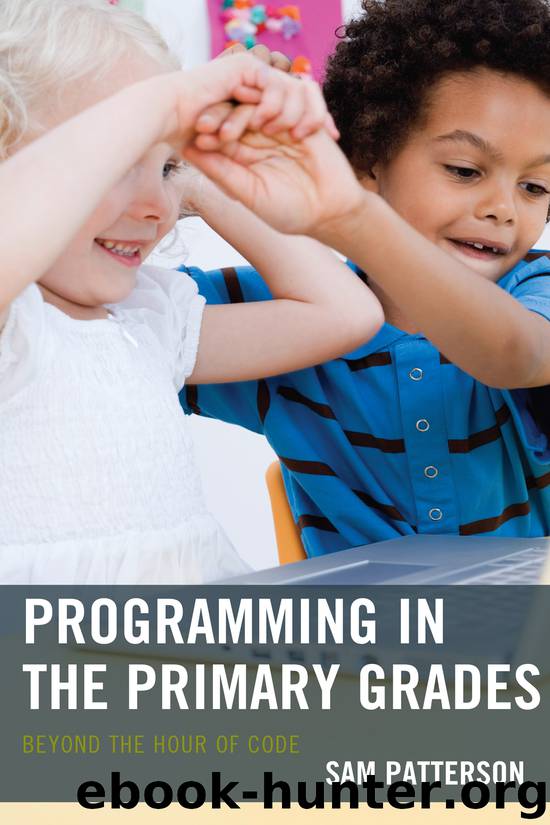Programming in the Primary Grades by Sam Patterson

Author:Sam Patterson
Language: eng
Format: epub
Publisher: Rowman & Littlefield Publishers
Chapter 7
Learning with Robots
Lesson Design in Three Dimensions
The idea of teaching young children by playing with robots seems both amazing and laughable. If it’s funny or strange, that’s only because it is difficult to imagine learning with a robot. Spoiler alert: it will not involve C3PO lecturing your students.
Learning with robots through programming and group work is a very kinesthetic form of learning. Understanding the roles a robot can play will help you design engaging and meaningful lessons. The role a robot can play in a lesson does depend on what a robot can do. While this text refers to several different robots, these are just a few of the ever-expanding selection of educational robots. For the most current and updated information about these robots, be sure to check BeyondtheHourofCode.com.
ROBOT AS POINTER
From the Desktop to Floor
Great news! You have lessons written that are almost robot ready. The most important element in a robot lesson is to make the location of the robot meaningful. A matching activity designed for desktop work can be adapted quickly to a robot activity. Many lessons take only two steps to convert from desktop to robot lesson:
1.Enlarge the images used in the desktop activity and place them on the floor.
2.Have students working in groups program a robot to move from the image to its match.
With this simple idea, you can place answers to math problems on the floor and have students navigate to the right answer once they have solved the problem. Students could also roll dice and navigate to the correct answer. This model of using the robot as a pointer to indicate the correct answer was the seed of a lesson in my colleague Tali’s kindergarten class. The robot used in this lesson was a Bee-Bot, a very simple robot that looks like a bumblebee and has a small wheelbase. It is programmed by pressing directional buttons on top of the robot. Every time the Bee-Bot moves, it moves 15 cm. The Bee-Bot runs on a grid of 15 sq. cm.
The objectives of this lesson:
1.Students will develop math skills (differentiated by skill).
2.Students will develop communication skills through group collaboration.
Planning this lesson requires knowledge of the students and their math abilities, but with this knowledge you can do some very meaningful differentiation. Tali had six robots to work with, so she divided her twenty-four students into six groups. She did not create groups of equal numbers. Instead, she created groups of similar math ability. With ability groups, she was able to customize the challenge level of the work to fit the students’ needs. Tali ensured engagement through differentiation.
The Groups
The core of this lesson is students do the math at hand and navigate the robot to the correct answer. Tali gave each group appropriate math to do and customized the robot’s grid with the answers needed.
The first group had two dice, and they were using a grid numbered 124. Even though they only used 112, the twenty-four square grid allows teachers to add a die if the students master the first activity.
Download
This site does not store any files on its server. We only index and link to content provided by other sites. Please contact the content providers to delete copyright contents if any and email us, we'll remove relevant links or contents immediately.
The Art of Coaching Workbook by Elena Aguilar(50035)
Trainspotting by Irvine Welsh(20940)
Twilight of the Idols With the Antichrist and Ecce Homo by Friedrich Nietzsche(18266)
Fangirl by Rainbow Rowell(8753)
Periodization Training for Sports by Tudor Bompa(7887)
Change Your Questions, Change Your Life by Marilee Adams(7317)
This Is How You Lose Her by Junot Diaz(6401)
Asking the Right Questions: A Guide to Critical Thinking by M. Neil Browne & Stuart M. Keeley(5317)
Grit by Angela Duckworth(5260)
Red Sparrow by Jason Matthews(5165)
Paper Towns by Green John(4751)
Room 212 by Kate Stewart(4700)
Ken Follett - World without end by Ken Follett(4410)
The Sports Rules Book by Human Kinetics(4041)
Housekeeping by Marilynne Robinson(4014)
Double Down (Diary of a Wimpy Kid Book 11) by Jeff Kinney(3872)
Papillon (English) by Henri Charrière(3869)
The Motorcycle Diaries by Ernesto Che Guevara(3754)
Exercise Technique Manual for Resistance Training by National Strength & Conditioning Association(3754)
